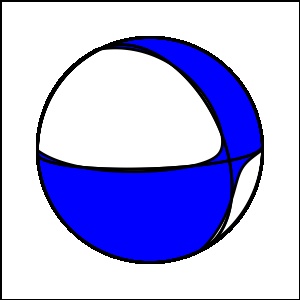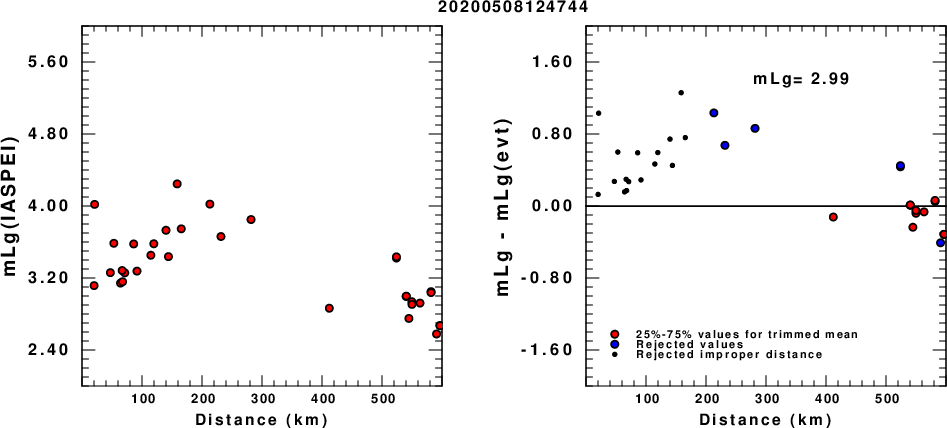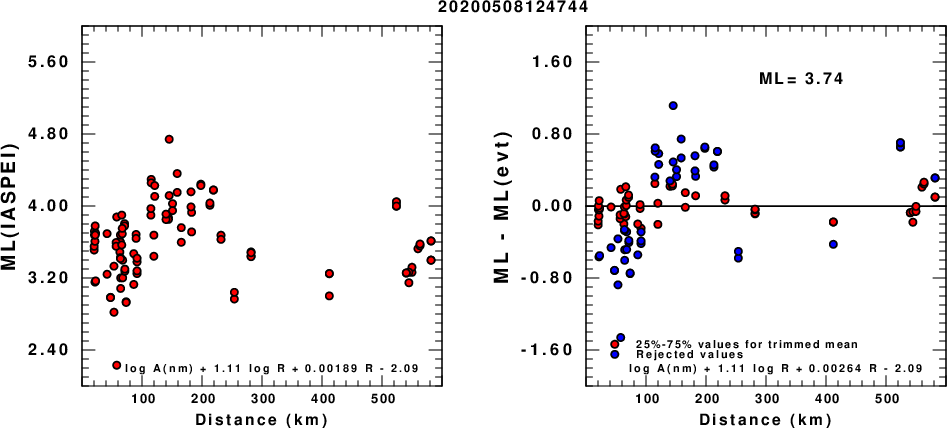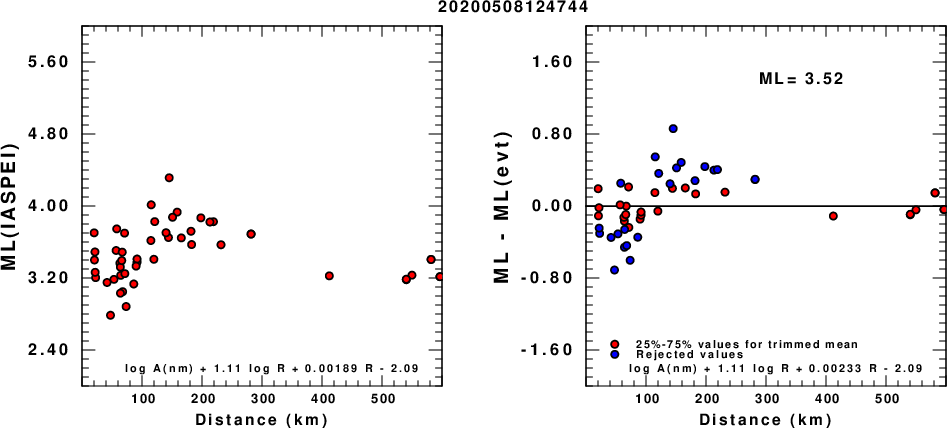Location
Location ANSS
2020/05/08 12:47:44 41.83 2.66 5.0 3.7 Catulunya, Spain
Focal Mechanism
USGS/SLU Moment Tensor Solution
ENS 2020/05/08 12:47:44:0 41.83 2.66 5.0 3.7 Catulunya, Spain
Stations used:
CA.ARBS CA.CAVN CA.CBEU CA.CBRU CA.CBUD CA.CCAS CA.CEST
CA.CGAR CA.CLLI CA.CMAS CA.CORG CA.CORI CA.CPAL CA.CSOR
CA.CTRE CA.EBR IU.PAB LC.CANF
Filtering commands used:
cut o DIST/3.3 -40 o DIST/3.3 +50
rtr
taper w 0.1
hp c 0.03 n 3
lp c 0.10 n 3
Best Fitting Double Couple
Mo = 1.16e+21 dyne-cm
Mw = 3.31
Z = 12 km
Plane Strike Dip Rake
NP1 5 55 -70
NP2 153 40 -116
Principal Axes:
Axis Value Plunge Azimuth
T 1.16e+21 8 81
N 0.00e+00 16 173
P -1.16e+21 72 326
Moment Tensor: (dyne-cm)
Component Value
Mxx -4.87e+19
Mxy 2.31e+20
Mxz -2.60e+20
Myy 1.07e+21
Myz 3.52e+20
Mzz -1.03e+21
----------####
#---------------######
###-----------------########
###-------------------########
####--------------------##########
#####---------------------##########
#####----------------------###########
######--------- -----------###########
######--------- P -----------#########
#######--------- -----------######### T
########----------------------#########
########----------------------############
#########---------------------############
########--------------------############
#########-------------------############
#########-----------------############
##########---------------###########
##########-------------###########
###########---------##########
############------##########
######################
#######-------
Global CMT Convention Moment Tensor:
R T P
-1.03e+21 -2.60e+20 -3.52e+20
-2.60e+20 -4.87e+19 -2.31e+20
-3.52e+20 -2.31e+20 1.07e+21
Details of the solution is found at
http://www.eas.slu.edu/eqc/eqc_mt/MECH.NA/20200508124744/index.html
|
Preferred Solution
The preferred solution from an analysis of the surface-wave spectral amplitude radiation pattern, waveform inversion and first motion observations is
STK = 5
DIP = 55
RAKE = -70
MW = 3.31
HS = 12.0
The NDK file is 20200508124744.ndk
The waveform inversion is preferred.
Moment Tensor Comparison
The following compares this source inversion to others
| SLU |
IGN |
USGS/SLU Moment Tensor Solution
ENS 2020/05/08 12:47:44:0 41.83 2.66 5.0 3.7 Catulunya, Spain
Stations used:
CA.ARBS CA.CAVN CA.CBEU CA.CBRU CA.CBUD CA.CCAS CA.CEST
CA.CGAR CA.CLLI CA.CMAS CA.CORG CA.CORI CA.CPAL CA.CSOR
CA.CTRE CA.EBR IU.PAB LC.CANF
Filtering commands used:
cut o DIST/3.3 -40 o DIST/3.3 +50
rtr
taper w 0.1
hp c 0.03 n 3
lp c 0.10 n 3
Best Fitting Double Couple
Mo = 1.16e+21 dyne-cm
Mw = 3.31
Z = 12 km
Plane Strike Dip Rake
NP1 5 55 -70
NP2 153 40 -116
Principal Axes:
Axis Value Plunge Azimuth
T 1.16e+21 8 81
N 0.00e+00 16 173
P -1.16e+21 72 326
Moment Tensor: (dyne-cm)
Component Value
Mxx -4.87e+19
Mxy 2.31e+20
Mxz -2.60e+20
Myy 1.07e+21
Myz 3.52e+20
Mzz -1.03e+21
----------####
#---------------######
###-----------------########
###-------------------########
####--------------------##########
#####---------------------##########
#####----------------------###########
######--------- -----------###########
######--------- P -----------#########
#######--------- -----------######### T
########----------------------#########
########----------------------############
#########---------------------############
########--------------------############
#########-------------------############
#########-----------------############
##########---------------###########
##########-------------###########
###########---------##########
############------##########
######################
#######-------
Global CMT Convention Moment Tensor:
R T P
-1.03e+21 -2.60e+20 -3.52e+20
-2.60e+20 -4.87e+19 -2.31e+20
-3.52e+20 -2.31e+20 1.07e+21
Details of the solution is found at
http://www.eas.slu.edu/eqc/eqc_mt/MECH.NA/20200508124744/index.html
|
Evid Date Time (UTC) Latitude Longitude Prof. centroid Mw Location
es2020jaxat 05/08/2020 12:47:44 41.8324 2.6683 5 3.5 S SANTA COLOMA DE FARNERS.GI
Components of the deviant TMS (null isotropic part) - (10 ^ 20 dyne-cm)
M0 mzz mxx myy mxz myz mxy
22.00E20 -9,806 9,874 -0.068 -16,582 3,796 9,833
TMS decomposition Double even percentage: 92 Dipole percentage: 8
Double pair: Plane A Double pair: Plane B
Azimuth: 88 Azimuth: 333
Dip: 75 Dip: 32
Glide: -119 Slip: -29
Fit quality
Variance reduction [0-100]: 67
Automatic TMS calculation detail
Available images
Focal Mechanism

|
Magnitudes
mLg Magnitude

(a) mLg computed using the IASPEI formula; (b) mLg residuals ; the values used for the trimmed mean are indicated.
ML Magnitude

(a) ML computed using the IASPEI formula for Horizontal components; (b) ML residuals computed using a modified IASPEI formula that accounts for path specific attenuation; the values used for the trimmed mean are indicated. The ML relation used for each figure is given at the bottom of each plot.

(a) ML computed using the IASPEI formula for Vertical components (research); (b) ML residuals computed using a modified IASPEI formula that accounts for path specific attenuation; the values used for the trimmed mean are indicated. The ML relation used for each figure is given at the bottom of each plot.
Context
The next figure presents the focal mechanism for this earthquake (red) in the context of other events (blue) in the SLU Moment Tensor Catalog which are within ± 0.5 degrees of the new event. This comparison is shown in the left panel of the figure. The right panel shows the inferred direction of maximum compressive stress and the type of faulting (green is strike-slip, red is normal, blue is thrust; oblique is shown by a combination of colors).
Waveform Inversion using wvfgrd96
The focal mechanism was determined using broadband seismic waveforms. The location of the event and the
and stations used for the waveform inversion are shown in the next figure.

|
|
Location of broadband stations used for waveform inversion
|
The program wvfgrd96 was used with good traces observed at short distance to determine the focal mechanism, depth and seismic moment. This technique requires a high quality signal and well determined velocity model for the Green functions. To the extent that these are the quality data, this type of mechanism should be preferred over the radiation pattern technique which requires the separate step of defining the pressure and tension quadrants and the correct strike.
The observed and predicted traces are filtered using the following gsac commands:
cut o DIST/3.3 -40 o DIST/3.3 +50
rtr
taper w 0.1
hp c 0.03 n 3
lp c 0.10 n 3
The results of this grid search from 0.5 to 19 km depth are as follow:
DEPTH STK DIP RAKE MW FIT
WVFGRD96 1.0 260 90 -5 2.90 0.2594
WVFGRD96 2.0 180 45 90 3.03 0.3081
WVFGRD96 3.0 85 55 20 3.12 0.2885
WVFGRD96 4.0 85 35 10 3.14 0.3341
WVFGRD96 5.0 10 90 -65 3.13 0.3908
WVFGRD96 6.0 10 90 -60 3.14 0.4381
WVFGRD96 7.0 10 90 -55 3.16 0.4703
WVFGRD96 8.0 5 80 -65 3.23 0.4924
WVFGRD96 9.0 0 65 -70 3.26 0.5151
WVFGRD96 10.0 0 60 -70 3.28 0.5377
WVFGRD96 11.0 0 55 -75 3.30 0.5527
WVFGRD96 12.0 5 55 -70 3.31 0.5589
WVFGRD96 13.0 5 55 -70 3.32 0.5567
WVFGRD96 14.0 5 55 -70 3.33 0.5478
WVFGRD96 15.0 10 55 -65 3.34 0.5350
WVFGRD96 16.0 10 55 -65 3.35 0.5184
WVFGRD96 17.0 10 55 -60 3.35 0.5005
WVFGRD96 18.0 10 55 -60 3.36 0.4846
WVFGRD96 19.0 10 55 -60 3.37 0.4664
WVFGRD96 20.0 10 55 -60 3.37 0.4480
WVFGRD96 21.0 10 50 -65 3.38 0.4303
WVFGRD96 22.0 15 50 -60 3.39 0.4137
WVFGRD96 23.0 15 50 -60 3.39 0.3993
WVFGRD96 24.0 15 50 -60 3.40 0.3842
WVFGRD96 25.0 15 50 -60 3.40 0.3696
WVFGRD96 26.0 195 70 -65 3.41 0.3637
WVFGRD96 27.0 195 65 -65 3.42 0.3591
WVFGRD96 28.0 195 65 -65 3.42 0.3551
WVFGRD96 29.0 200 65 -65 3.43 0.3513
The best solution is
WVFGRD96 12.0 5 55 -70 3.31 0.5589
The mechanism correspond to the best fit is

|
|
Figure 1. Waveform inversion focal mechanism
|
The best fit as a function of depth is given in the following figure:

|
|
Figure 2. Depth sensitivity for waveform mechanism
|
The comparison of the observed and predicted waveforms is given in the next figure. The red traces are the observed and the blue are the predicted.
Each observed-predicted component is plotted to the same scale and peak amplitudes are indicated by the numbers to the left of each trace. A pair of numbers is given in black at the right of each predicted traces. The upper number it the time shift required for maximum correlation between the observed and predicted traces. This time shift is required because the synthetics are not computed at exactly the same distance as the observed and because the velocity model used in the predictions may not be perfect.
A positive time shift indicates that the prediction is too fast and should be delayed to match the observed trace (shift to the right in this figure). A negative value indicates that the prediction is too slow. The lower number gives the percentage of variance reduction to characterize the individual goodness of fit (100% indicates a perfect fit).
The bandpass filter used in the processing and for the display was
cut o DIST/3.3 -40 o DIST/3.3 +50
rtr
taper w 0.1
hp c 0.03 n 3
lp c 0.10 n 3

|
|
Figure 3. Waveform comparison for selected depth. Red: observed; Blue - predicted. The time shift with respect to the model prediction is indicated. The percent of fit is also indicated.
|

|
|
Focal mechanism sensitivity at the preferred depth. The red color indicates a very good fit to thewavefroms.
Each solution is plotted as a vector at a given value of strike and dip with the angle of the vector representing the rake angle, measured, with respect to the upward vertical (N) in the figure.
|
A check on the assumed source location is possible by looking at the time shifts between the observed and predicted traces. The time shifts for waveform matching arise for several reasons:
- The origin time and epicentral distance are incorrect
- The velocity model used for the inversion is incorrect
- The velocity model used to define the P-arrival time is not the
same as the velocity model used for the waveform inversion
(assuming that the initial trace alignment is based on the
P arrival time)
Assuming only a mislocation, the time shifts are fit to a functional form:
Time_shift = A + B cos Azimuth + C Sin Azimuth
The time shifts for this inversion lead to the next figure:

The derived shift in origin time and epicentral coordinates are given at the bottom of the figure.
Discussion
Acknowledgements
Thanks also to the many seismic network operators whose dedication make this effort possible: University of Nevada Reno, University of Alaska, University of Washington, Oregon State University, University of Utah, Montana Bureau of Mines, UC Berkely, Caltech, UC San Diego, Saint Louis University, University of Memphis, Lamont Doherty Earth Observatory, the Oklahoma Geological Survey, TexNet, the Iris stations, the Transportable Array of EarthScope and other networks.
Velocity Model
The WUS.model used for the waveform synthetic seismograms and for the surface wave eigenfunctions and dispersion is as follows:
MODEL.01
Model after 8 iterations
ISOTROPIC
KGS
FLAT EARTH
1-D
CONSTANT VELOCITY
LINE08
LINE09
LINE10
LINE11
H(KM) VP(KM/S) VS(KM/S) RHO(GM/CC) QP QS ETAP ETAS FREFP FREFS
1.9000 3.4065 2.0089 2.2150 0.302E-02 0.679E-02 0.00 0.00 1.00 1.00
6.1000 5.5445 3.2953 2.6089 0.349E-02 0.784E-02 0.00 0.00 1.00 1.00
13.0000 6.2708 3.7396 2.7812 0.212E-02 0.476E-02 0.00 0.00 1.00 1.00
19.0000 6.4075 3.7680 2.8223 0.111E-02 0.249E-02 0.00 0.00 1.00 1.00
0.0000 7.9000 4.6200 3.2760 0.164E-10 0.370E-10 0.00 0.00 1.00 1.00
Quality Control
Here we tabulate the reasons for not using certain digital data sets
The following stations did not have a valid response files:
Last Changed Wed May 13 14:27:35 CDT 2020










